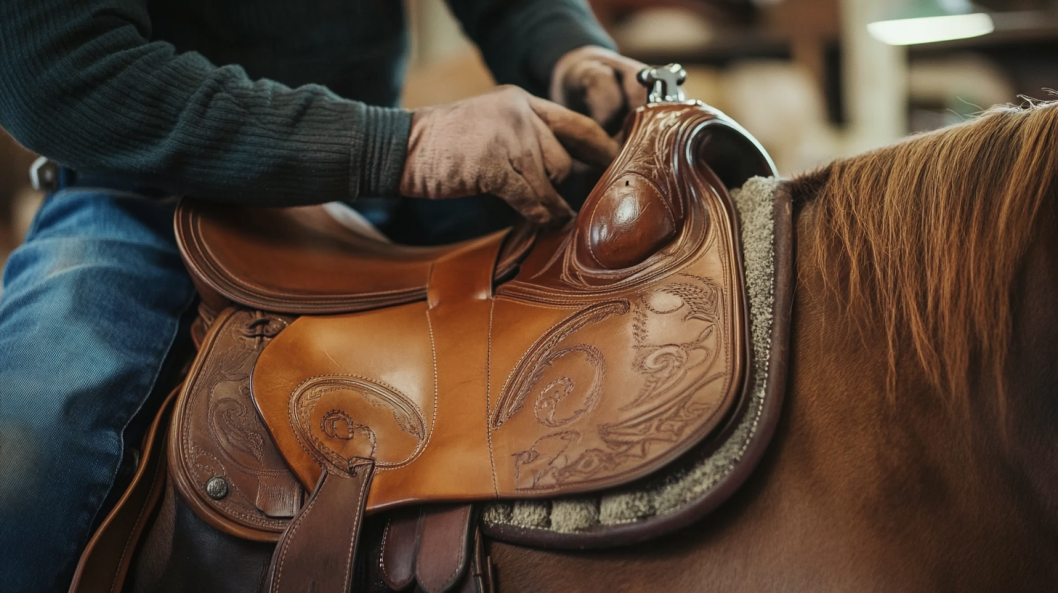Finding the perfect saddle fit for your horse is crucial for the animal’s comfort and riding experience. A well-fitted saddle ensures your horse can move freely and comfortably, preventing long-term health issues and improving your riding experience.
A poorly fitted saddle can lead to discomfort, behavioral issues, and even long-term injuries, while a well-fitted saddle enhances movement, stability, and enjoyment for both horse and rider. In my opinion, finding the perfect saddle fit isn’t just a matter of comfort; it’s essential for maintaining your horse’s health and ensuring a harmonious rider-horse relationship. Here’s a comprehensive guide to ensure your saddle fits your horse perfectly.
1. Understand the Importance of Saddle Fitting
A well-fitted saddle ensures even weight distribution, preventing pressure points and allowing your horse to move freely. It also affects your riding position and control. Investing time in proper fitting will lead to a happier, healthier horse and a more enjoyable riding experience.
2. Assess Your Horse’s Body Shape
Before fitting a saddle, you must understand your horse’s body shape. Horses come in various shapes and sizes, so a one-size-fits-all approach doesn’t work. Key areas to consider include:
- Withers: The area just above the shoulder blades.
- Back Shape: The curve of the horse’s back, whether flat, high, or low.
- Girth Area: Where the saddle will sit to the girth.
3. Choose the Right Saddle Type
Different disciplines require different types of saddles. For example, dressage saddles have a deeper seat and longer flaps, while jumping saddles have a forward flap and a more open seat. Make sure you select a saddle suited to your riding discipline.
4. Check Saddle Size and Fit
- Seat Size: Ensure that the seat size fits your body. You should be able to sit comfortably without feeling cramped or too loose.
- The gullet width should provide enough clearance for your horse’s spine. Measure the width of the gullet to ensure it aligns with the shape of your horse’s withers and back.
- Tree Size and Shape: The saddle’s tree (the internal frame) should match the shape of your horse’s back. Different tree shapes accommodate various back profiles.
5. Place the Saddle on Your Horse
When placing the saddle on your horse’s back:
- Centring: Ensure the saddle is centered and positioned correctly, about two fingers behind the withers.
- Balance: Check that the saddle is level and not tilting forward or backwards.
- Clearance: There should be enough clearance between the saddle and the withers, typically about two to three fingers’ width.
6. Check for Pressure Points
When you first ride with the saddle:
- Even Pressure: Ensure the saddle distributes pressure evenly across your horse’s back.
- Movement: Watch your horse’s movement. The saddle should not restrict the horse’s range of motion or cause discomfort.
7. Adjust the Girth and Straps
Ensure the girth is adjusted evenly and snugly. The saddle should not shift excessively. Check all straps and fittings for proper adjustment and alignment.
8. Test Ride
After fitting, take your horse for a test ride. Observe:
- Comfort: Notice any signs of discomfort or agitation from your horse.
- Performance: Ensure that the saddle allows for fluid movement and doesn’t interfere with your riding or your horse’s performance.
9. Regular Checks and Adjustments
Saddle fit can change over time due to your horse’s growth, weight changes, or muscle development. Regularly check the fit and make adjustments as needed.
10. Consult a Professional
If you’re unsure about any aspect of saddle fitting, consult a professional saddle fitter or an experienced equestrian. They can provide expert advice and adjustments to ensure the best fit for your horse.
Proper saddle fitting is essential for your horse’s comfort and your effectiveness as a rider. I’ve observed that the benefits of a properly fitted saddle extend beyond immediate comfort. A saddle that fits well enhances the horse’s range of motion, reduces the risk of injury, and fosters a more positive and productive relationship between horse and rider. It’s an investment in your horse’s health and performance that pays dividends in the long run.





